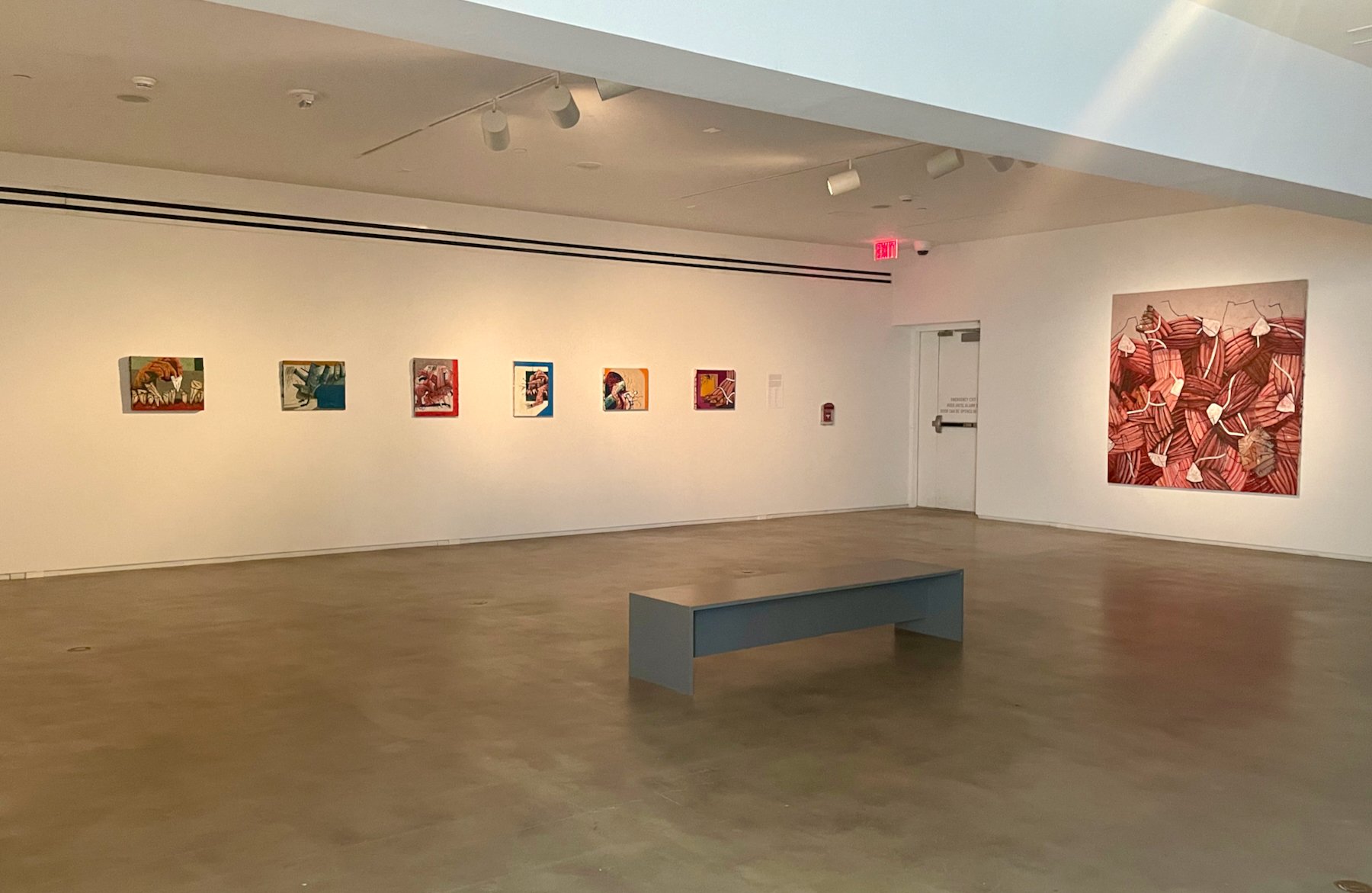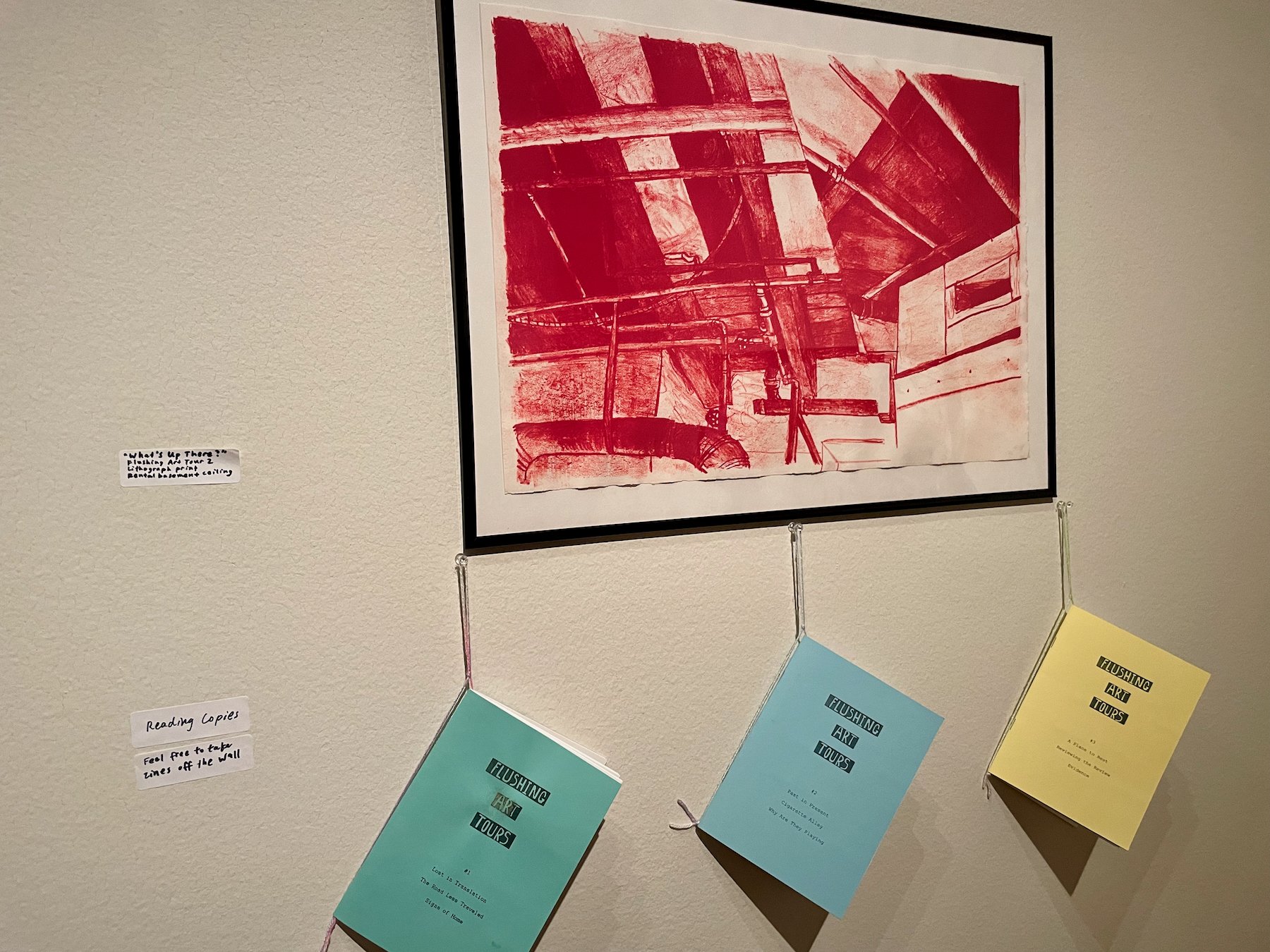It is Wednesday, September 20th, 2023, and Houston is in the midst of an exciting exhibition season. I am taking a moment to pause, because the flood of events, exhibitions, and artworks is starting to become a blur. Having just resurfaced after the city’s second worst summer in recent history (2011 being the first), my head is scrambling to make sense of everything I’ve seen.
Asia Society initiated the season with a closing reception for Artists on Site Series 4. There, I saw Alexis Pye’s ongoing work, an installation of imagined landscapes by Farima Fooladi, new and old work by Naomi Kuo, and large abstract works by Tatiana Escallón.
I spent the majority of my time in Naomi Kuo’s space as I was unfamiliar with her work. I was immediately excited to explore the booklets she had on display. Sitting in one of the two camp chairs, I read about her project “Flushing Art Tours” which is documented in a series of booklets. Each booklet documents a three person interactive walk that took place in Flushing, Queens. The project was particularly compelling as it sought to strengthen the relationship between place and people in a creative, participatory manner.
Naomi Kuo at Asia Society
The following week, the rush of shows began. Lorena Molina: At What Cost: Part II at Assembly. Currents at Basket Books. Christopher Myers at Blaffer Art Museum. William Kentridge: In Praise of Shadows at MFAH. The Kentridge show was a great opportunity to revisit his work, but the Broad’s presentation had more space to expand and gave viewers a chance to really sit with the work. It was less compelling in a confined space and without “The Refusal of Time” (2012), a five-channel video installation with sound; four megaphones and a breathing machine… however it was exciting to gawk and see him in person at a talk with Christopher Blay.
Crisscrossing midtown, the events continued with a Li Harris performance at DiverseWorks and a second exhibition at Basket Books, Adam Marnie: Red. I had no idea what to expect throughout the performance at DiverseWorks and found myself remarkably exhausted by the end. Performance, particularly one with an emphasis on music or sound, continues to be a foreign medium. Red, on other hand, is very familiar. Paired with blue, the color red has preoccupied my practice since 2020.
Walking upstairs to Basket Books’ exhibition space is always exciting–a mysterious adventure like climbing into a tree house. For this exhibition, the viewer, while still ascending the stairs, is immediately confronted with Red Delicious apples and plaster white fists (Twin Infinitives, 2023) scattered on the floor.
Marnie’s red is sourced from a limited array of hues ranging from Coke Red (#F4009) and Trump Red (#C8303A). I like how the exhibition describes the color as an “expressive misnomer or deflecting shield” which is particularly evident in Recursion (2014), the inkjet color prints mounted on drywall. The three panel work sits on the farthest wall of the exhibition and has ambition too reach either side of the room. Across from Recursion, Knotted Object and Dead Wackers stare backward. A small broken branch (Wound Object, 2023) lies opposed to each wall at the center of the room on a podium.
Red is an exhibition that starts with a succession of quick bold punches and follows with a series of questions to ponder more slowly. Admittedly I didn’t like that first jolt, but I quite enjoy reflecting on it now.
Adam Marnie at Basket Books
This past week, I jumped between John Guzman’s Flesh and Bone, Jospeh Havel’s 451 at Pazda Butler, Ruhee Maknojia’s Pattern and Power, Garret Griffin’s Relics at Front Gallery, and the culminating exhibition of The Sankofa Project at Lawndale. Whew. That takes a few breathes to recite aloud.
John Guzman’s show (which is up through this weekend) is a comprehensive survey of his fleshy and rough paintings. Thick paint and bits of grime extend off the edges. Houston viewers may recognize a physical likeness to Philip Guston’s work having recently hosted his retrospective at the MFAH. Following Guzman’s work online, I wish Blaffer had included some of Guzman’s sculptures as well.
Visiting Pazda Butler for the first time, I blindly attended the opening excited to see Joseph Havel’s latest work. The paintings, which perform much like drawings, are airy yet very much grounded in the earth. Prior to visiting the exhibition, I didn’t note the exhibition’s title. I went in blindly and knew only that Havel had recently been working in France. The work was installed without cards so I looked on without much context. I saw fire, red ochre, sienna, and mars black and my mind jumped to the Lascaux Caves in France and paleolithic artwork more generally.
Then I spoke to Havel and realized my silliness for not remembering the exhibition title, “451”, which nods to Ray Bradbury’s novel and the temperature at which paper burns. Havel witnessed France’s recent protests that reached a violent pitch in March 2023.
Referring to the work checklist, I learned the titles of each work (“Of Mice and Men”, “Beloved”, etc) and the materials used (including locally sourced spices). While inspired by events in France, this exhibition feels grounded in the United States–perhaps more specifically Houston.
Joseph Havel at Josh Pazda Hiram Butler
That was my pause. Get ready, we have another art-filled weekend ahead.
The exhibitions mentioned and still on view:
John Guzman: Flesh and Bone on view at The Blaffer Art Museum through September 24, 2023.
Adam Marnie: The Red Show at Basket Books through October 14, 2023.
Joseph Havel: 451 on view Pazda Butler through October 28, 2023.
All are open to the public/free.
Oh, wait there is more to still write about! Garret Griffin: Relics, Ruhee Maknojia: Pattern and Power at Anya Tish, and Sankofa 23 at Lawndale. More notes to come. Keep hitting pause everyone.



